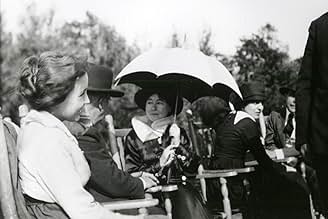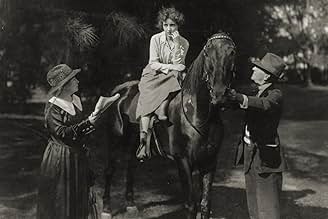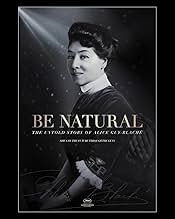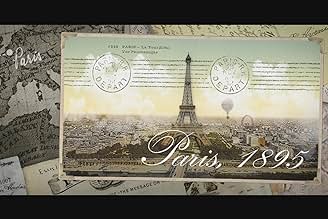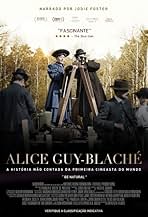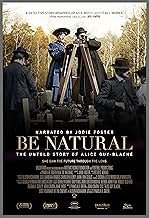Be Natural : L'Histoire cachée d'Alice Guy-Blaché
Original title: Be Natural: The Untold Story of Alice Guy-Blaché
- 2018
- Tous publics
- 1h 43m
IMDb RATING
7.7/10
1.2K
YOUR RATING
Pamela B. Green's energetic film about pioneer filmmaker Alice Guy-Blaché is both a tribute and a detective story, tracing the circumstances by which this extraordinary artist faded from mem... Read allPamela B. Green's energetic film about pioneer filmmaker Alice Guy-Blaché is both a tribute and a detective story, tracing the circumstances by which this extraordinary artist faded from memory and the path toward her reclamation.Pamela B. Green's energetic film about pioneer filmmaker Alice Guy-Blaché is both a tribute and a detective story, tracing the circumstances by which this extraordinary artist faded from memory and the path toward her reclamation.
- Awards
- 11 wins & 11 nominations total
Jodie Foster
- Narrator
- (voice)
Jon M. Chu
- Self
- (as Jon Chu)
- Director
- Writers
- All cast & crew
- Production, box office & more at IMDbPro
Featured reviews
Greetings again from the darkness. History can easily be distorted by those who tell it. But the work and deeds of those who make history stands the test of time, and research can often right a wrong ... or at least provide credit where it's due. Such is the case with Pamela B Greene's project to uncover the truth, and finally give pioneer filmmaker Alice Guy-Blache her rightful place in the history of cinema.
Numerous familiar faces from the movie industry flash across the screen, and most admit they have never heard of Alice Guy-Blache. Even the few that recognize the name, don't know her story. This is how the movie starts ... letting off the hook those of us who pride ourselves on knowing the basics of cinema's origins. In 1895, the Lumiere Brothers presented the first short films on their newly developed Cinematographe. In the audience that day were Leon Gaumont and his assistant, Alice Guy.
Young Ms. Guy had a creative vision for this fascinating new technology. Rather than filming "real life", she would tell stories. And telling stories through moving pictures is exactly what she did more than 1000 times across two decades and two countries. In 1896, she directed THE CABBAGE FAIRY, one of the first narrative films ... and it was only the beginning for her. Director Greene explains that so many of those early films are lost, despite being described as sophisticated, emotional, and engaging works. As she moved from France to the United States (New Jersey), Alice founded Solax with her husband, and began experimenting with sound, special effects, gender roles, and story structure.
It's truly fascinating to see the clips from many of her films, along with snippets from interviews she sat for in 1964 (before passing away in 1968). Director Greene also includes interviews from Alice's daughter Simone, while I believe are from the 1980's. Simone is able to fill in some of the gaps in the historical timeline ... a timeline that includes many familiar names. It's also a timeline that results in an abrupt end to Alice's filmmaking when she relocates back to France after the war.
How did Alice Guy-Blache get lost in history? She was a contemporary of Melies, Lumiere and the Pathe brothers. She was not just the first woman director, she was also one of the first film directors, period. Though the search continues for many of her films, Oscar winning actress Jodie Foster narrates the mission of filmmaker Pamela B Greene to right a wrong ... Alice must no longer be forgotten by the industry she helped create.
Numerous familiar faces from the movie industry flash across the screen, and most admit they have never heard of Alice Guy-Blache. Even the few that recognize the name, don't know her story. This is how the movie starts ... letting off the hook those of us who pride ourselves on knowing the basics of cinema's origins. In 1895, the Lumiere Brothers presented the first short films on their newly developed Cinematographe. In the audience that day were Leon Gaumont and his assistant, Alice Guy.
Young Ms. Guy had a creative vision for this fascinating new technology. Rather than filming "real life", she would tell stories. And telling stories through moving pictures is exactly what she did more than 1000 times across two decades and two countries. In 1896, she directed THE CABBAGE FAIRY, one of the first narrative films ... and it was only the beginning for her. Director Greene explains that so many of those early films are lost, despite being described as sophisticated, emotional, and engaging works. As she moved from France to the United States (New Jersey), Alice founded Solax with her husband, and began experimenting with sound, special effects, gender roles, and story structure.
It's truly fascinating to see the clips from many of her films, along with snippets from interviews she sat for in 1964 (before passing away in 1968). Director Greene also includes interviews from Alice's daughter Simone, while I believe are from the 1980's. Simone is able to fill in some of the gaps in the historical timeline ... a timeline that includes many familiar names. It's also a timeline that results in an abrupt end to Alice's filmmaking when she relocates back to France after the war.
How did Alice Guy-Blache get lost in history? She was a contemporary of Melies, Lumiere and the Pathe brothers. She was not just the first woman director, she was also one of the first film directors, period. Though the search continues for many of her films, Oscar winning actress Jodie Foster narrates the mission of filmmaker Pamela B Greene to right a wrong ... Alice must no longer be forgotten by the industry she helped create.
I HAD heard of Guy-Blache, but then I have been a silent film geek for almost 50 years now. Have been catching what I can on-line of her work - so far, 1916 The Ocean Waif is the best, Doris Kenyon was a far more natural actress then Pickford or the Gish sisters based on that film.
I think that Simon could have skipped including so many phone interviews with distance relatives of Guy-Blache, (many of which could have used subtitles, I found them hard to understand) and included some longer clips of her actual films instead. It is obvious that a lot of work went into digging up information on Guy-Blache, and I appreciate it, but would rather have seen more of her work than her family life. Still, I gave it 9 out of 10 stars since the subject matter is so important to film history...and I LOVE the opening postcard collages that take the viewer back in time and across the ocean!
I think that Simon could have skipped including so many phone interviews with distance relatives of Guy-Blache, (many of which could have used subtitles, I found them hard to understand) and included some longer clips of her actual films instead. It is obvious that a lot of work went into digging up information on Guy-Blache, and I appreciate it, but would rather have seen more of her work than her family life. Still, I gave it 9 out of 10 stars since the subject matter is so important to film history...and I LOVE the opening postcard collages that take the viewer back in time and across the ocean!
I went to see this film following a strong review in Melbourne (Australia). However, I thought that it was very poorly assembled as a film. It seemed that the film's makers were keen to include absolutely everything they could find, and the choice of order for all these clips was baffling as well as non-stop. I will be the first in the queue to see another film made to cover the astonishing life of Alice Guy-Blache - she deserves better than this attempt.
One evening in Paris in March of 1895, cinema pioneers Auguste and Louis Lumière hosted a special event, the very first public screening of projected motion pictures. In the audience that night were Leon Gaumont, maker of cameras and photographic equipment, and his secretary, 21 year-old Alice Guy. What they saw were "actualities," basic documentary works that were brief and simple, such as the now-familiar scene of workers leaving the Lumière factory. Guy was impressed, but felt the subject matter could be improved upon. So she sought permission from her employer to make her own motion pictures -- ones that told stories -- and it was granted. Her film-making career was underway.
The Gaumont concern became a motion picture plant, and from 1896 to 1906 Alice Guy was the company's head of production. Dozens of short films were made under her direction, in every genre: comedies, dramas, fantasies, Biblical epics, and even Westerns. She experimented with special effects, including double-exposure and synchronized sound. She married Herbert Blaché in 1907 and the two worked together, first in France and then in the U.S. They co-founded the Solax Company on the East Coast; Alice now ran her own studio.
She continued making films of all kinds, including features, eventually in Hollywood. But for a number of reasons, both personal and professional, the filmmaking career of Alice Guy-Blaché came to a premature halt shortly after the First World War. She returned to France in 1922 and made no more films. And for the rest of her long life, Guy-Blaché struggled to establish her place in motion picture annals. This proved to be a battle, for most of her films were lost or unavailable, and film historians tended to overlook her achievements or ascribe them to others.
Pamela Green's fascinating new documentary should help rectify the injustice done to this pioneer. I happened to see it the same weekend I caught Peter Bogdanovich's new Buster Keaton documentary, and the difference between the two is striking. While I enjoyed the Keaton tribute, it's traditional in every way, following the standard format for such works as it cuts back and forth between film excerpts, photos, and interviews. And of course, Keaton's life story and his comedies are familiar to buffs. But Green, whose subject is far more obscure, takes a more audacious approach: she gives us not only biographical material about Guy-Blaché, complete with the expected footage and photos, but also details her own efforts to dig up material on Alice Guy-Blaché and complete the documentary. This is illustrated throughout with lively animated graphics, which help clarify complicated details and keep the viewer engaged.
Happily, in addition to the excerpts from Guy-Blaché's films, Green also found two interviews with the filmmaker from her later years. It's fascinating to hear the woman herself discuss her life and career. We get the sense she was somewhat frustrated but nonetheless even-tempered and philosophical about setbacks as she describes her ongoing efforts to locate her surviving work and establish her claim as a genuine pioneer. A videotaped interview with Guy-Blaché's daughter conducted in the 1980s helps fill in some of the gaps.
In sum, this is a captivating story, told in a fresh, innovative fashion. It's must for anyone interested in the birth of the motion picture as an art form and an industry.
The Gaumont concern became a motion picture plant, and from 1896 to 1906 Alice Guy was the company's head of production. Dozens of short films were made under her direction, in every genre: comedies, dramas, fantasies, Biblical epics, and even Westerns. She experimented with special effects, including double-exposure and synchronized sound. She married Herbert Blaché in 1907 and the two worked together, first in France and then in the U.S. They co-founded the Solax Company on the East Coast; Alice now ran her own studio.
She continued making films of all kinds, including features, eventually in Hollywood. But for a number of reasons, both personal and professional, the filmmaking career of Alice Guy-Blaché came to a premature halt shortly after the First World War. She returned to France in 1922 and made no more films. And for the rest of her long life, Guy-Blaché struggled to establish her place in motion picture annals. This proved to be a battle, for most of her films were lost or unavailable, and film historians tended to overlook her achievements or ascribe them to others.
Pamela Green's fascinating new documentary should help rectify the injustice done to this pioneer. I happened to see it the same weekend I caught Peter Bogdanovich's new Buster Keaton documentary, and the difference between the two is striking. While I enjoyed the Keaton tribute, it's traditional in every way, following the standard format for such works as it cuts back and forth between film excerpts, photos, and interviews. And of course, Keaton's life story and his comedies are familiar to buffs. But Green, whose subject is far more obscure, takes a more audacious approach: she gives us not only biographical material about Guy-Blaché, complete with the expected footage and photos, but also details her own efforts to dig up material on Alice Guy-Blaché and complete the documentary. This is illustrated throughout with lively animated graphics, which help clarify complicated details and keep the viewer engaged.
Happily, in addition to the excerpts from Guy-Blaché's films, Green also found two interviews with the filmmaker from her later years. It's fascinating to hear the woman herself discuss her life and career. We get the sense she was somewhat frustrated but nonetheless even-tempered and philosophical about setbacks as she describes her ongoing efforts to locate her surviving work and establish her claim as a genuine pioneer. A videotaped interview with Guy-Blaché's daughter conducted in the 1980s helps fill in some of the gaps.
In sum, this is a captivating story, told in a fresh, innovative fashion. It's must for anyone interested in the birth of the motion picture as an art form and an industry.
10puckamo
The director spent a decade of her life gathering evidence that Alice Guy-Blache was one of the founders of cinema, on the same level as the Lumiere Brothers, Georges Melies and Thomas Edison, and the case she makes is completely convincing. This film should be seen by everyone interested in movie history.
Did you know
- TriviaOriginal written source: "Alice Guy Blaché: Lost Visionary of the Cinema", book by Alison McMahan, Bloomsbury Publishing, London, 2002, 408 p., ISBN: 978-0826451576.
- Quotes
Bob Channing: If it wasn't for people like you, she'd just remain buried.
- ConnectionsFeatures Dickson Experimental Sound Film (1894)
- How long is Be Natural: The Untold Story of Alice Guy-Blaché?Powered by Alexa
Details
- Release date
- Country of origin
- Official sites
- Languages
- Also known as
- Be Natural : L'Histoire inédite d'Alice Guy-Blaché
- Filming locations
- Production companies
- See more company credits at IMDbPro
Box office
- Gross US & Canada
- $117,511
- Opening weekend US & Canada
- $3,237
- Apr 21, 2019
- Gross worldwide
- $210,247
- Runtime
- 1h 43m(103 min)
- Color
Contribute to this page
Suggest an edit or add missing content



